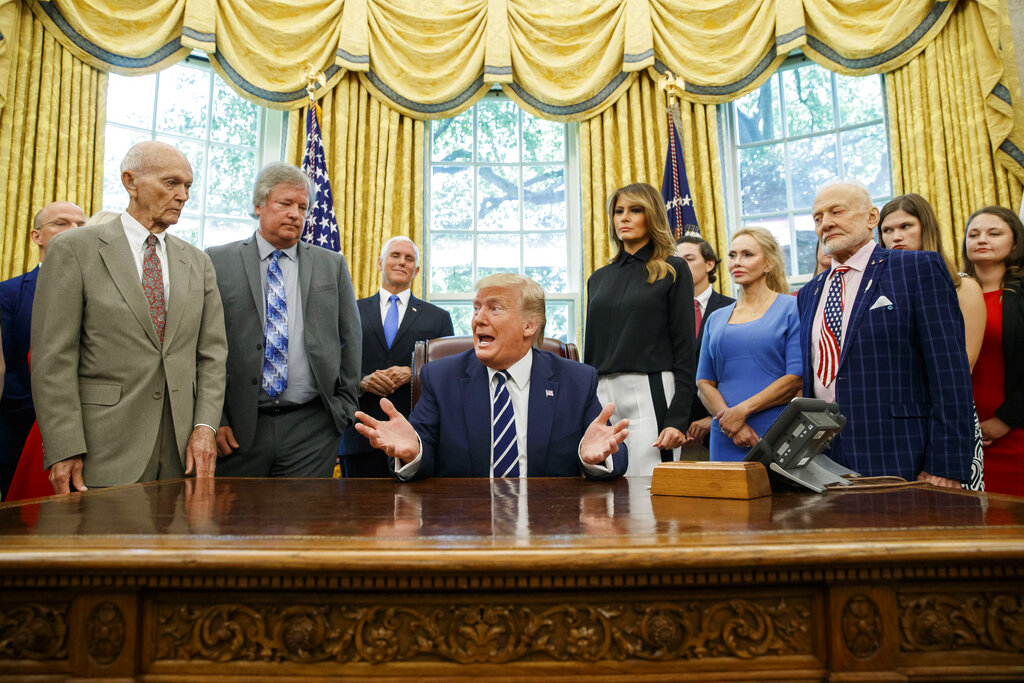Apollo 11 astronauts reunite on 50th anniversary of moonshot

President Donald Trump, accompanied by Apollo 11 astronauts Michael Collins, left, and Buzz Aldrin, right, and Eric “Rick” Armstrong, son of Neil Armstrong, second from left, with Vice President Mike Pence and first lady Melania Trump, speaks during a photo opportunity commemorating the 50th anniversary of the Apollo 11 moon landing, in the Oval Office of the White House, Friday, July 19, 2019, in Washington. (AP)
CAPE CANAVERAL, Florida — Apollo 11 astronauts Buzz Aldrin and Michael Collins reunited Friday on the eve of the 50th anniversary of humanity’s first moon landing.
They gathered in the Oval Office with President Donald Trump, who got a rundown on his administration’s plans to get astronauts back on the moon by 2024 and then on to Mars in the 2030s.
“We’re bringing the glamour back” to the space program, Trump said.
Both sons of the late Neil Armstrong, the first man to step onto the moon on July 20, 1969, also attended, as well as first lady Melania Trump, Vice President Mike Pence and NASA Administrator Jim Bridenstine.
RELATED TOPICS Apollo 11: 50 Year Moon Landing Anniversary How a Vintage Film Format Brought ‘Apollo 11’ Back to Life NASA Scraps All-Women Spacewalk for Lack of Well-Fitting SuitsThe moon versus Mars debate as astronauts’ next destination arose again Friday.
The president asked if astronauts could get to Mars without first going back to the moon.
Collins, 88, who circled the moon alone in the command module while Armstrong and Aldrin descended in the Eagle, told the president that he supports going directly to Mars and bypassing the moon.
“It seems to me Mars direct, who knows better than these people?” Trump noted.
Bridenstine, though, stressed the importance of the moon as a training ground and noted that because of the planetary alignment, launches to Mars can occur only every 26 months and even then the trip is seven months each way.
“What happens if you miss the timing? They’re in deep trouble? Trump asked. “You don’t want to be on that ship.”
Aldrin, meanwhile, said he’s disappointed with the state of human space exploration the past 10 or 15 years. “We were able to achieve so much early,” the 89-year-old said.
Aldrin, whose specialty was orbital rendezvous, doesn’t like NASA’s idea for a small space station around the moon, called the Gateway, from which to stage lunar landings and, eventually, Mars trips. He noted that the Apollo 11 command module and attached lunar module went straight into lunar orbit and even separated and redocked around the moon.
“We have the No. 1 rocket right now in the U.S. and we have the No. 1 spacecraft, and they cannot get into lunar orbit with significant maneuvering capability,” Aldrin pointed out.
Trump directed Bridenstine to listen to the “other side.”
Aldrin and Armstrong, who died in 2012, landed on the Sea of Tranquility at 4:17 p.m. on July 20, 1969. “Houston, Tranquility Base here. The Eagle has landed,” Armstrong radioed.
Armstrong was the first to climb down the ladder, stepping onto the lunar surface at 10:56 p.m. His “That’s one small step for man, one giant leap for mankind,” is arguably the most famous space line of all time.
The vice president is commemorating Saturday’s anniversary at Florida’s Kennedy Space Center, visiting the launch pad where Apollo 11 blasted off.
Museums and towns across the country geared up for their own golden anniversary celebrations, including Wapakoneta, Ohio, Armstrong’s hometown that was serving up “cinnamoon pancakes” and “buckeye on the moon sundaes.” The U.S. Postal Service, meanwhile, issued its “1969: First Moon Landing” Forever stamps Friday at Kennedy.
NASA televised a two-hour show Friday afternoon remembering Apollo 11 but also looking forward to its future moon plans. At the end of the program, Bridenstine revealed the new logo for the moon program, called Artemis after the twin sister of Greek mythology’s Apollo.
Besides Wapakoneta and Kennedy, the program went live to Johnson Space Center in Houston, home to Mission Control; the U.S. Space and Rocket Center next door to Marshall Space Flight Center in Huntsville, Alabama; and the National Air and Space Museum in Washington.
In Houston, Apollo 7 astronaut Walter Cunningham said the moon landings will be remembered hundreds of years from now and Armstrong, in particular, will go down in history.
“Here we are 50 years later, and I never in my life could have projected this amount of interest and association with what we were doing back then,” Cunningham said.
In Wapakoneta, former astronaut Don Thomas recalled how he invited fellow Ohioan Armstrong to one of his four space shuttle launches in the 1990s. Not only did Armstrong show up, Thomas said the moonwalker met with him the day before liftoff and promised to stick around as long as it took the shuttle to fly.
“It was the thrill of my life to have him there for the launch,” Thomas said.